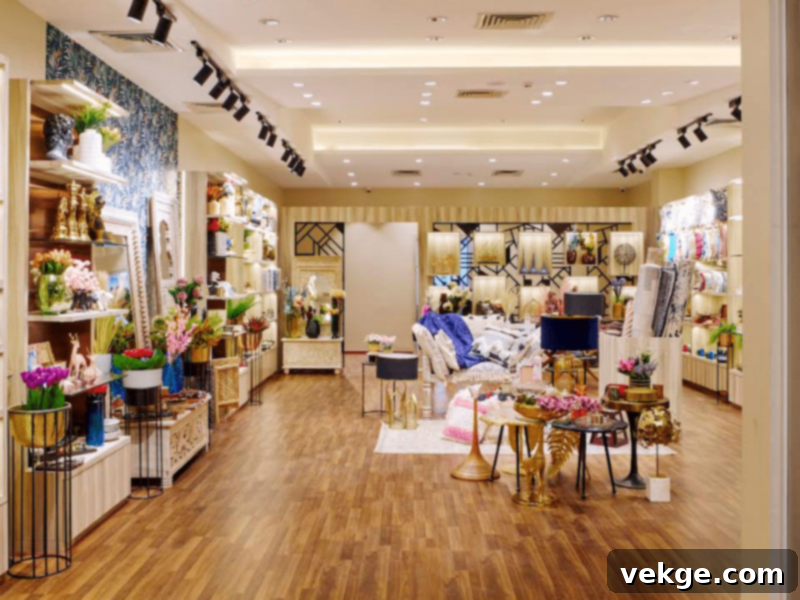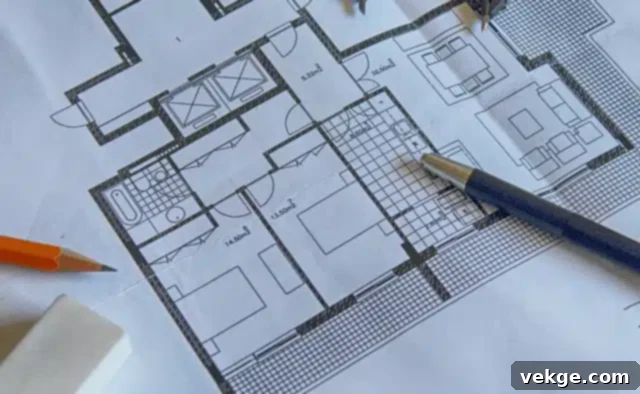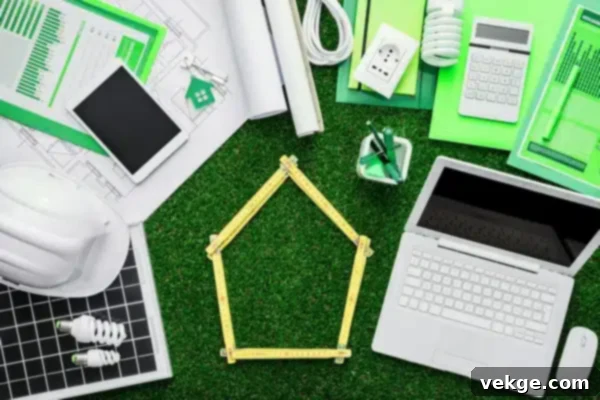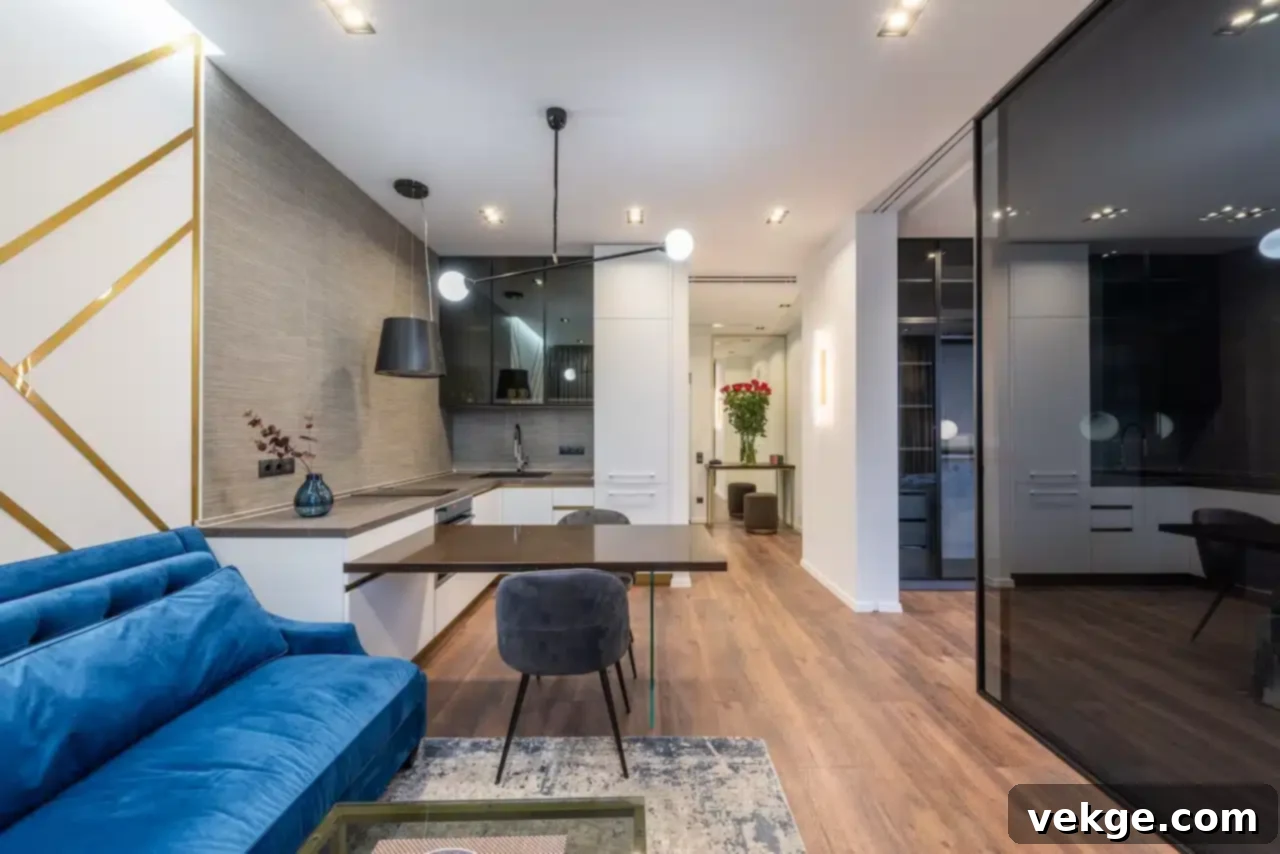Your Ultimate Guide to Planning a Seamless Interior Design Makeover
Dreaming of a home that perfectly reflects your personality, enhances your lifestyle, and evokes joy every single day? An interior design makeover is the transformative journey that can turn that dream into a tangible reality. However, embarking on such a significant project without a well-defined strategy can often lead to unexpected challenges, costly mistakes, and results that fall short of your vision. A successful interior overhaul isn’t just about picking pretty furniture; it’s about meticulous planning, thoughtful execution, and a clear understanding of your needs and desires.
This comprehensive guide will walk you through the essential steps to create an effective plan, ensuring a smooth execution from conception to completion. By following these tried-and-tested tactics, you can confidently navigate your interior design journey, avoid common pitfalls, and achieve a beautifully designed space that you’ll love for years to come.
Define Your Design Vision

Before you even think about browsing an interior design showroom or scrolling through your favorite Pinterest boards, the very first and most crucial step is to clearly define your desired aesthetic and overall vision. This isn’t just about choosing colors; it’s about understanding the feeling you want your home to evoke. What kind of atmosphere do you crave? Are you drawn to the clean lines and functionality of modern minimalism, the comforting warmth of rustic farmhouse charm, the eclectic vibrance of bohemian style, or perhaps the sophisticated elegance of vintage glamor?
Explore Design Styles and Personal Preferences
Delve into various design styles to see what truly resonates with you. Consider how your existing architecture might influence your choices – a historic home might lend itself well to traditional or classic contemporary designs, while a modern loft could thrive with industrial or minimalist aesthetics. Think about your personality: are you bold and adventurous, or do you prefer calm and serene? Your home should be an extension of yourself.
Crafting Your Vision Board
To clarify your aesthetic preferences, create a vision board. This can be a physical collage of magazine clippings, fabric swatches, and paint chips, or a digital board using platforms like Pinterest or Houzz. Collect images that inspire you, paying attention to specific elements such as color palettes, textures, furniture shapes, lighting fixtures, and decorative accents. This exercise helps you visualize your dream space and ensures your subsequent design choices will flow seamlessly, creating a cohesive and harmonious look throughout your home.
Measure Your Space Accurately

Accurate measurements are the bedrock of successful space planning and furniture selection. Without precise dimensions, you risk purchasing items that are too large or too small, disrupting the balance and flow of your rooms. Take the time to meticulously measure each room’s dimensions: length, width, and ceiling height. Don’t forget to include critical architectural features such as doorways, windows, fireplaces, built-in shelving, and even electrical outlets.
Sketching Your Layout and Floor Plans
Once you have your measurements, sketch a detailed layout of each room. This doesn’t require artistic talent; a simple bird’s-eye view drawing will suffice. Mark the placement and size of all fixed elements. This sketch will be an invaluable tool when visualizing furniture placement, assessing traffic flow, and determining scale. Consider using graph paper or online floor planning tools for more precision. Always measure twice to avoid costly errors.
Inventory Existing Furniture and Decor
Next, make a comprehensive list of your existing furniture and decor. For each item, note its dimensions, condition, and whether you intend to keep it, sell it, donate it, or repurpose it. This inventory serves several purposes: it helps you identify gaps in your current furnishings, prevents unnecessary purchases of items you already own or don’t need, and allows you to integrate beloved pieces into your new design scheme. Knowing what you have and what you need is a crucial step in efficient planning.
Consider Functionality And Flow

A beautiful space is only truly successful if it’s also highly functional. Before making any design decisions, deeply consider how you and your family use each room in your daily life. This understanding of your lifestyle is paramount to creating spaces that are both aesthetically pleasing and genuinely practical.
Analyze Your Lifestyle and Room Usage
Does your living space need to accommodate cozy movie nights, lively family gatherings, or perhaps a quiet reading nook? Does your kitchen require ample counter space for gourmet cooking, a breakfast bar for quick meals, or extensive storage for a large family? If you work from home, does a corner of your bedroom need to double as an office? Consider your routines, habits, and the activities you enjoy most, and adjust your design plans accordingly. The goal is to design around your life, not the other way around.
Optimizing Traffic Flow and Zone Planning
Create a functional layout that promotes smooth and unobstructed traffic flow throughout your home. Ensure there are clear pathways between furniture pieces and into/out of rooms. Furniture should facilitate movement, not impede it. Additionally, think about “zone planning” – dedicating specific areas within a larger room for different activities. For instance, in an open-concept living area, you might have a conversation zone, a dining zone, and a children’s play zone, each defined by clever furniture arrangement, rugs, or lighting. Prioritize the activities you enjoy most in each space, designing layouts that support and enhance those experiences.
Set A Realistic Budget

Interior design, whether a small refresh or a full-scale renovation, can be a significant financial investment. Therefore, establishing a clear and realistic budget upfront is absolutely critical to avoid overspending and financial stress. Your budget will influence every decision, from material choices to the scope of your project.
Comprehensive Cost Breakdown
Begin by outlining all potential costs. Beyond the obvious furniture and decor, consider expenses such as:
- Structural Changes: If you’re moving walls or reconfiguring layouts.
- Surface Updates: Painting, wallpaper, flooring (hardwood, tile, carpet), cabinetry.
- Lighting: Fixtures, installation, electrical work.
- Window Treatments: Blinds, curtains, shutters.
- Hardware: Door handles, cabinet pulls.
- Professional Fees: If you hire an interior designer, architect, contractor, or other skilled tradespeople.
- Delivery and Installation: Costs associated with getting new items to your home and setting them up.
Research and Contingency Planning
Research average costs for your desired materials, finishes, and services in your local area. Get multiple quotes from contractors and suppliers. Once you have a preliminary budget, always factor in a contingency fund – typically 10-20% of your total budget – for unexpected expenses or last-minute changes. This buffer is crucial for managing unforeseen issues without derailing your entire project. Prioritize your spending: decide which elements are “must-haves” where you’re willing to invest more, and where you can economize without compromising your vision. A well-planned budget keeps your interior design makeover on track and within your financial comfort zone.
Research And Gather Inspiration

With your vision defined and your space measured, now comes one of the most exciting parts of the design process: researching and gathering inspiration. This phase is about exploring possibilities and refining your aesthetic to create a truly personalized interior.
Where to Find Inspiration
Delve into a wide array of sources. Pore over interior design magazines and books for curated aesthetics. Explore popular websites and blogs that focus on home decor and lifestyle. Utilize social media platforms like Pinterest and Instagram, which are treasure troves of visual ideas. Don’t limit yourself to online sources; visit local showrooms, art galleries, and even open houses to experience different styles and layouts firsthand. Travel can also be a profound source of inspiration, exposing you to diverse architectural and design traditions.
Creating Mood Boards and Digital Collages
As you gather inspiration, compile images and ideas that deeply resonate with your style and functionality needs. Pay close attention to various elements: color palettes that evoke your desired mood, intriguing textures that add depth, functional furniture arrangements, unique lighting ideas, and decorative elements that speak to your personality. Create physical mood boards with actual samples of fabrics, paint chips, and material swatches, or compile digital collages. These boards serve as visual blueprints, helping you consolidate your ideas, refine your design direction, and ensure all elements work harmoniously together. This iterative process allows you to experiment, discard, and hone your vision until it feels just right.
Shop For Your Furnishings

Once your budget is set, your inspiration gathered, and your vision crystal clear, you can confidently begin the exciting process of shopping for the furnishings and decor that will bring your design to life. This phase requires a strategic approach to ensure every purchase aligns perfectly with your overall plan.
Where and How to Shop
Start by identifying the best interior design showrooms in your area, as well as reputable online retailers. Research and shortlist those that fit your aesthetic and budget. Visiting showrooms allows you to see, touch, and test pieces in person, which is crucial for evaluating comfort, material quality, and true color. When shopping online, pay close attention to dimensions, customer reviews, and return policies. Don’t be afraid to mix and match from different sources – a blend of high-end pieces, affordable finds, and unique vintage items often creates the most interesting and personalized spaces.
Prioritizing Comfort and Quality
As you make your selections, always prioritize comfort and material quality, especially for investment pieces like sofas, beds, and dining tables. These items will see heavy use and should be built to last. Read labels, inquire about construction methods, and understand the durability of fabrics and finishes. While budget is important, remember that investing in well-made pieces can save you money in the long run by reducing the need for frequent replacements.
Seeking Professional Assistance for Selections
If you find yourself overwhelmed by the vast array of choices or unsure about specific selections, don’t hesitate to connect with a professional interior designer. Their expertise can be invaluable in guiding your choices, ensuring that every piece is “up to mark” in terms of style, scale, comfort, and quality. Professional insight can help you avoid making costly, unfit choices that you might regret later, ensuring your furnishings perfectly complement your evolving space.
Embrace Professional Guidance

While a DIY approach to your home’s interior makeover can be rewarding, it’s not always the most efficient or effective path, especially for larger or more complex projects. If you’re unsure how to begin revamping your space, lack the time, or simply wish to achieve a truly polished and professional result, embracing professional guidance is a smart investment.
When to Hire a Professional
Consider onboarding professionals if your project involves significant structural changes, a complete overhaul of multiple rooms, or if you’re struggling to translate your vision into a cohesive design. Interior designers bring a wealth of expertise in space planning, color theory, material selection, and access to trade-only resources. They can help navigate complex decisions, manage contractors, and ensure your project stays on schedule and within budget. Their objective eye can also offer fresh perspectives and prevent costly mistakes.
Benefits of Professional Expertise
Hiring an interior designer or an architect ensures your space not only achieves a premium look and feel but also maximizes its functionality and aesthetic potential. Professionals can interpret your vision, refine it with their knowledge, and execute it with precision, delivering results that often exceed what could be achieved alone. Their involvement can impress your guests with a sophisticated, well-thought-out environment.
For instance, consider leveraging the architectural expertise of Michael Bell Architects for your interior design planning. Their team excels in blending architectural prowess with interior design finesse, crafting spaces that are not only functional but distinctly refined and structurally sound. By involving a firm like Michael Bell Architects, you gain access to professional guidance that ensures your design choices are both aesthetically pleasing and architecturally viable. This integrated approach leads to a high-quality transformation and a sophisticated home environment that will truly impress, adding lasting value and timeless elegance.
Create A Detailed Plan

Before any remodeling work begins or a single piece of furniture is ordered, it is paramount to finalize your design plan down to the smallest detail. This comprehensive document serves as your roadmap, guiding every step of the interior design journey and ensuring that everyone involved – whether yourself, family members, or hired professionals – is on the same page.
Components of a Comprehensive Design Plan
Your detailed plan should encompass all aspects of your envisioned space. This includes:
- Detailed Floor Plans: Showing exact furniture placement and traffic flow.
- Furniture Selections: With precise dimensions, material specifications, and supplier information.
- Color Schemes: Specific paint codes, wallpaper selections, and fabric choices.
- Material Schedules: For flooring, countertops, backsplashes, and other surfaces.
- Lighting Plans: Placement of fixtures, types of light (ambient, task, accent), and switch locations.
- Decorative Elements: Art, mirrors, accessories, and their intended placement.
- Project Timeline: A realistic schedule for each phase of the makeover, from demolition to final installation.
- Budget Breakdown: Detailed allocation of funds for each item and service.
Streamlining the Process and Mitigating Risk
Having such a clear and exhaustive roadmap at your fingertips is invaluable. It eliminates ambiguity, prevents miscommunication, and significantly diminishes the risk of costly mistakes or unexpected delays. It allows for a streamlined process, providing a consistent reference point for all decisions and ensuring the final outcome precisely matches your initial vision. Regularly review and update this plan as needed, but always strive to adhere to its core principles.
Prioritize Quality And Sustainability

While budget considerations are undeniably important, a truly successful and enduring interior design makeover also places a strong emphasis on quality and sustainability. These two principles are interconnected and contribute significantly to the long-term value, beauty, and ethical footprint of your home.
The Value of Quality Investment
Prioritize quality over quantity when selecting furniture, finishes, and materials. Investing in well-made, durable pieces might seem like a larger upfront cost, but it invariably saves you money in the long run. High-quality items stand the test of time, resisting wear and tear, reducing the need for frequent replacements, and often retaining their aesthetic appeal and structural integrity for decades. This approach ensures your home remains beautiful and functional without constant updates, reflecting a thoughtful and economically sound design philosophy. Look for solid construction, reputable brands, and robust materials.
Embracing Sustainable Design Choices
Beyond durability, consider the environmental impact of your choices. Embrace sustainable options for a guilt-free and eco-conscious makeover. This involves opting for materials made from recycled or upcycled content, ethically sourced wood and natural fibers, or rapidly renewable resources like bamboo. Choose paints and finishes with low volatile organic compounds (VOCs) to improve indoor air quality. Support local artisans and businesses, which reduces transportation emissions and fosters community. Think about energy-efficient lighting and appliances. By incorporating sustainable practices, you not only create a healthier home environment for your family but also contribute positively to the planet, making your space a testament to responsible living.
Final Thoughts
Embarking on an interior design makeover is an exciting journey, and the difference between a good outcome and a truly impressive one lies in the strength of your planning. A solid, spot-on plan builds a firm foundation for your space remodeling, guiding every decision and ensuring that the final result is not just beautiful, but also highly functional, deeply personal, and aligned perfectly with your initial vision.
By meticulously defining your design vision, accurately measuring your space, prioritizing functionality, setting a realistic budget, diligently gathering inspiration, making informed furnishing choices, and embracing professional guidance when needed, you create a comprehensive roadmap to success. Furthermore, by committing to quality and sustainability, you ensure your redesigned home is not only stunning but also durable, comfortable, and ethically conscious.
So, go ahead and follow these shared tactics. Take the time to plan your makeover with precision and passion. The reward will be a beautifully designed interior that you’ll cherish for years to come – a true reflection of your style and a sanctuary perfectly tailored to your life.
